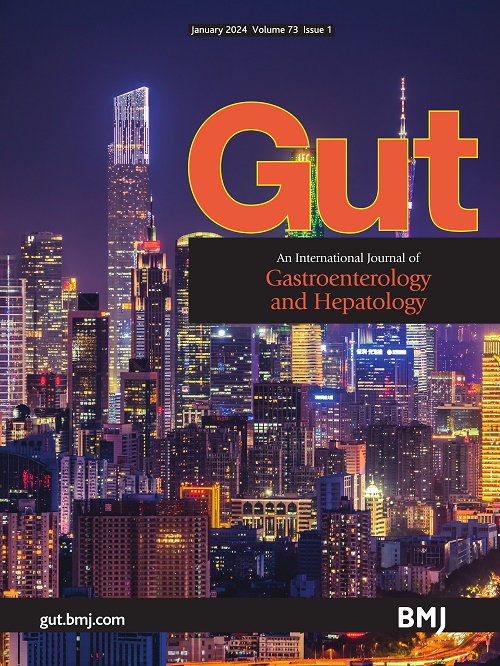Impaired glucose metabolism in irritable bowel syndrome: personalised low-glycaemic diet as potential therapeutic target
IF 25.8
1区 医学
Q1 GASTROENTEROLOGY & HEPATOLOGY
引用次数: 0
Abstract
We read with great interest the recent study by Gilliam-Vigh et al demonstrating significant transcriptomic alterations in the intestinal mucosa of individuals with type 2 diabetes (T2D), particularly increased immune activation, altered barrier function in the large intestine and metabolic dysfunction.1 These findings provide crucial mechanistic insights that complement observations on metabolic disturbances in patients with irritable bowel syndrome (IBS), supporting the rationale for glucose-targeted interventions. Given the substantial interindividual variability in glycaemic responses,2 we investigated the therapeutic potential of a personalised low-glycaemic diet (PLGD) in IBS management. In our nutritional observation study of 20 age and gender-matched patients with IBS, we compared clinical outcomes between those receiving either a PLGD or the established low-FODMAP diet (LFD) over a minimum 3-month period (figure 1). Figure 1 Precomparison and postcomparison in IBS Severity Scoring System (IBS-SSS) between age- and gender-matched patients with IBS receiving either a personalised low-glycaemic diet (PLGD, n=10) or a standard therapy low in fermentable oligosaccharides, disaccharides, monosaccharides and polyols (FODMAP) diet (LFD, n=10) using paired Wilcoxon test. The group means are represented by a dashed line, and an arrow represents the reduction in IBS-SSS, with a reduction between 50 and 230 points in PLGD and between 30 and 290 points in LFD. *P<0.05. Remarkably, our personalised nutrition (PN) approach achieved symptom improvement comparable to standard LFD, assessed …肠易激综合征的糖代谢受损:个体化低血糖饮食是潜在的治疗靶点
我们非常感兴趣地阅读了Gilliam-Vigh等人最近的研究,该研究表明,2型糖尿病(T2D)患者的肠黏膜存在显著的转录组学改变,特别是免疫激活增加、大肠屏障功能改变和代谢功能障碍这些发现提供了重要的机制见解,补充了对肠易激综合征(IBS)患者代谢紊乱的观察,支持了葡萄糖靶向干预的基本原理。考虑到血糖反应的个体间差异,我们研究了个体化低血糖饮食(PLGD)在IBS治疗中的治疗潜力。在我们对20名年龄和性别匹配的IBS患者的营养观察研究中,我们比较了接受PLGD或既定低fodmap饮食(LFD)至少3个月的临床结果(图1)。图1使用配对Wilcoxon检验,年龄和性别匹配的IBS患者接受个性化低血糖饮食(PLGD, n=10)或低发酵寡糖、双糖、单糖和多元醇(FODMAP)饮食(LFD, n=10)的IBS严重性评分系统(IBS- sss)前、后比较。组均值用虚线表示,箭头表示IBS-SSS的减少,PLGD的减少在50 - 230分之间,LFD的减少在30 - 290分之间。* P < 0.05。值得注意的是,我们的个性化营养(PN)方法取得了与标准LFD相当的症状改善,评估…
本文章由计算机程序翻译,如有差异,请以英文原文为准。
求助全文
约1分钟内获得全文
求助全文
来源期刊

Gut
医学-胃肠肝病学
CiteScore
45.70
自引率
2.40%
发文量
284
审稿时长
1.5 months
期刊介绍:
Gut is a renowned international journal specializing in gastroenterology and hepatology, known for its high-quality clinical research covering the alimentary tract, liver, biliary tree, and pancreas. It offers authoritative and current coverage across all aspects of gastroenterology and hepatology, featuring articles on emerging disease mechanisms and innovative diagnostic and therapeutic approaches authored by leading experts.
As the flagship journal of BMJ's gastroenterology portfolio, Gut is accompanied by two companion journals: Frontline Gastroenterology, focusing on education and practice-oriented papers, and BMJ Open Gastroenterology for open access original research.
 求助内容:
求助内容: 应助结果提醒方式:
应助结果提醒方式:


